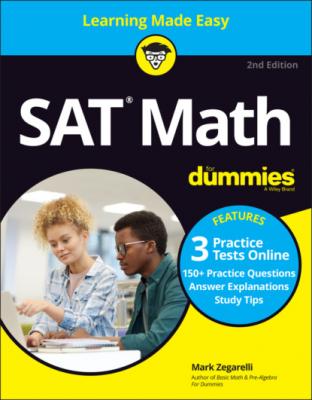SAT Math For Dummies with Online Practice. Mark Zegarelli
Чтение книги онлайн.
Читать онлайн книгу SAT Math For Dummies with Online Practice - Mark Zegarelli страница 10

That’s a total of 58 questions, each of which counts for 1 point on your raw score of correct answers (from 0 to 58). This raw score is converted to a scaled score (from 200 to 800), which becomes your SAT math score.
Using the Reference list of formulas
Every SAT math section (No Calculator and Calculator) includes a handy Reference list of formulas that you can use while taking the test, as shown in Figure 1-1. As you can see, this list includes a variety of geometric formulas for the area and circumference of a circle, the area of a rectangle and triangle, the Pythagorean Theorem, and other favorites.
FIGURE 1-1: The Reference list of formulas for the SAT.
Filling answers into the grid
Thirteen of the 58 math questions you’ll answer when taking the SAT are gridded-response questions. These are Questions 16 to 20 of the No Calculator math test and Questions 31 to 38 of the Calculator math test. To answer them, you need to fill in the grid provided with your answer sheet.
Most students don’t find the grid too difficult to work with. The official SAT instructions for using the grid are provided on every test just before the gridded-response questions. Here are a few things to keep in mind as you work with the grid:
The grid has four columns, into each of which you can place a digit from 0 to 9, or in some columns a fraction slash (/) or a decimal point (.).
Be sure to fill in the appropriate bubble in each column so the computer can read your answer. If you don’t, your answer will be marked wrong.
Use the boxes at the top for recording your answer so you can read it easily and change it if necessary.
The grid contains no minus sign, so all answers are non-negative numbers. (This includes “0”.)
If your answer is a whole number, you can enter it into the grid using any consecutive boxes. For example, here are three equally valid ways to enter the answer “23”:232323
If your answer is a fraction, use the fraction slash to record your answer. For example, here are two equally valid ways to enter the answer “1/2”.1/21/2
Don’t attempt to enter a mixed number such as into the grid, because the computer will read this answer as and mark it wrong. Instead, convert mixed numbers to improper fractions or decimals () and use one of these formats to enter your answer.
If your answer is a decimal that’s less than 1, use the decimal point without a leading zero to record your answer. For example, you can enter the answer “.5” in any of following ways:.5.5.5
If your answer is a decimal with more decimal places than will fit in the grid, fill in as many decimal places as will fit, either truncating the last decimal place or rounding it up. For example, here are the two ways you can enter the decimal 3.479 into the grid:3.473.48
Overview of SAT Math Topics
The math that’s covered on the SAT is very closely tracked to the math that’s covered in most U.S. high school math classes. So if you’re a current or recent U.S. high school student, you’re probably familiar with most of this curriculum.
The SAT breaks this down into three general areas of study: Heart of Algebra, Problem Solving and Data Analysis, and Passport to Advanced Math (and Other Topics). In this section, I give you an overview of each of these topics.
Heart of Algebra
Heart of Algebra centers on the linear function
Evaluating, simplifying, and factoring algebra expressions (Chapter 3)
Solving algebra equations and inequalities (Chapter 4)
Working with linear functions in four complementary ways: words, tables, graphs, and equations (Chapter 5)
Solving systems of equations (both linear and non-linear), and identifying when such systems have either no solution or infinitely many solutions (Chapter 6)
In Part 2, I cover all these topics in depth.
Problem Solving and Data Analysis
Problem Solving and Data Analysis focuses on a short list of problem-solving techniques:
Working with ratios, proportional equations, and percentages (Chapter 7)
Relying on a basic understanding of statistics and probability (Chapter 8)
Applying these techniques to information presented visually in tables and graphs (Chapter 9)
Part 3 focuses exclusively on these ideas.
Passport to Advanced Math (and Other Topics)
Passport to Advanced Math (and Other Topics) requires you to understand a core of information covered in high school Algebra II:
Working with functions using notation, and knowing how to graph a core of basic functions and their most elementary transformations (Chapter 10)
Understanding how to work with and graph polynomials, especially linear, quadratic, cubic, and quartic polynomials (Chapter 11)
Graphing